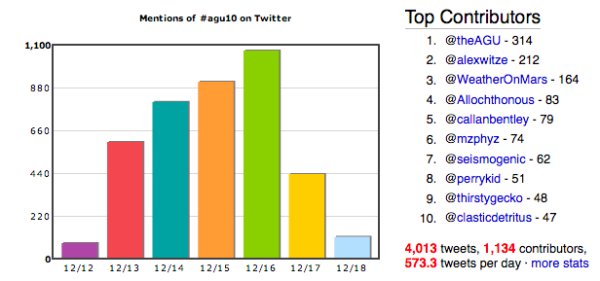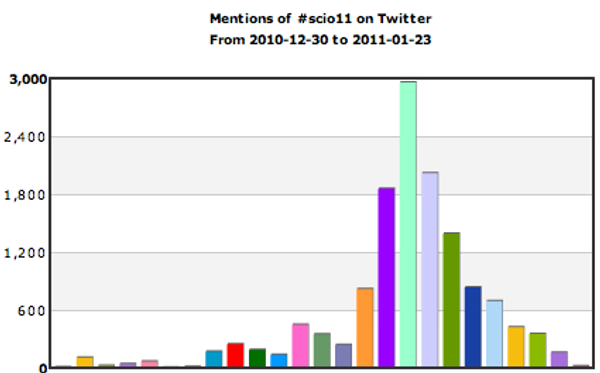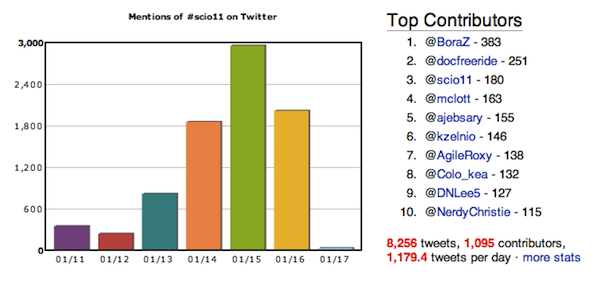![]() In the last couple of months, I’ve attended two conferences – the ScienceOnline in North Carolina – which had a Twitter hashtag that allowed tweets about the conference to be amalgamated together into a single stream. Based on my impressions of how they were used, I thought it would be interesting to compare statistics from the two hashtags over the week of their respective conferences, courtesy of What the Hashtag (and, in the case of the #AGU10 tweets, AGU press officer Maria Jose Vinas).
In the last couple of months, I’ve attended two conferences – the ScienceOnline in North Carolina – which had a Twitter hashtag that allowed tweets about the conference to be amalgamated together into a single stream. Based on my impressions of how they were used, I thought it would be interesting to compare statistics from the two hashtags over the week of their respective conferences, courtesy of What the Hashtag (and, in the case of the #AGU10 tweets, AGU press officer Maria Jose Vinas).

Tweets from AGU Fall Meeting: conference ran Monday 13th through Friday 17th December 2010.
| #scio11 | #AGU10 | |
| Attendees | 300 | 18,800 |
| People Tweeting | 1,095 (365% of attendees) | 1,134 (6% of attendees) |
| Total Tweets | 8,256 (7.5 tweets/person) | 4,013 (3.5 tweets/person) |
| Tweets from top 10 tweeters | 1,792 (21.7%) | 1,136 tweets (28.3%) |
| Retweets | 42% | 37.4% |
| Mentions | 66.7% | 47.2% |
At first glance, a few things stand out in these statistics:
- ScienceOnline was by far the smaller conference in terms of attendance – 300 against almost 19,000 at AGU – yet generated more than twice as many comments on Twitter over the week of the conference. Of course, it is hardly a surprise that a conference about online communication will involve a disproportionately high amount of online communication.
- At both conferences around 1,000 different people were using the conference hashtag. This means that the average person tweeting from ScienceOnline posted twice as many updates as the average person tweeting from AGU, However, perhaps more significant is that whilst 1,000 people is a little more than 1 in every 20 attendees at AGU, it is more than 3 times the total number of people in attendance at ScienceOnline. Even if everyone in North Carolina was using Twitter, it seems that significant numbers of people not in attendance were following the conference. Perhaps they were watching the video streaming of some sessions and adding their commentary; perhaps they were retweeting observations from people who were at the conference; perhaps they were even asking questions (I attended at least one session where questions were submitted over Twitter by people who were not in that room). This level of wider interaction was not happening during the AGU conference.
- The 10 top tweeters at AGU produced a much higher proportion of the total tweets than at ScienceOnline, meaning that a larger number of people were making significant contributions to the online conversation.
- Retweets, and especially mentions, were higher at ScienceOnline. I suspect this probably reflects the fact that most of the people at ScienceOnline know each other to some degree, which led to more of the social components of the conference spilling online.
This is only the most basic of analyses, but it does square with my different impressions of the hashtag stream from the two conferences. There has been some debate in the past few days about the utility of the #scio11 hashtag, with some saying it was too noisy and self-referential to be useful. I’m not sure I agree. It’s certainly true that it’s far from being a lower bandwith version of a video stream: you’re not getting a chronological record of everything that was said. But what you can get is a sense of the overall flavour of the conference at any particular moment: which sessions are provoking thought, discussion or controversy, which things that someone has said have particularly resonated. For example, I was not in the “Perils of blogging as a woman under a real name” session, so I missed the flabbergasted silence that fell when Ed Yong commented on how women bloggers never message him, asking him to promote their posts (see the accounts here or here). But I did get some sense of the impact this comment had (mainly from the exclamation points in the tweets about it, if I recall correctly). In short I treated the hashtag tweet stream like the cheers and chanting of a crowd at a football match; by listening to them, you aren’t going to extract a full narrative of the game, but you can get an idea of the moments that are exciting, important, or controversial.
In contrast, tweets on the AGU hashtag felt much more disconnected – it was much harder to get any unified sense of what was going on. The conference was so much bigger that it was quite rare to have more than one person (if that) posting updates from any one session. Of course, there are so many sessions running in parallel that if you did have several people tweeting from each one it would probably be completely overwhelming: parsing the updates coming in from 4 different sessions is possible, but 50? I think that would be too much without session/discipline specific hashtags to help filter the torrent.
Also, if my own experience of tweeting from AGU was anything to go by, the style of the presentations – in that they were quite technical presentations of new data, rather than discussions – tended to restrict my tweets, as I needed to be writing and sketching non-140 character things in my notebook instead (perhaps this was part of the explanation for the lower rate of tweets per person compared to ScienceOnline). The fact that tweeting can’t seem to substitute for my paper notebook at conferences like AGU definitely gives me some pause, as it takes away a large part of the motivation for conference tweeting for me.
All this combined to make the stream from the AGU hashtag feel less like a rowdy several hundred person conversation, and more like a lot of people individually shouting into the wilderness. The ScienceOnline hashtag might have seemed noisy, but at least there was a signal beneath it, if you looked at it in the right way. And it is this signal – the underlying conversations – that make Twitter valuable. To emphasise this point, I will conclude with two more comparative graphs, showing the number of times the #scio11 and #AGU10 hashtags were used in the days leading up to, and the days following, the conference.

scio11 tweeting before and after the conference.

AGU10 tweeting before and after the conference.
One group were talking to each other before, during (shown by the higher mentions) and after the conference. The other group? Not so much. I think this highlights the real issue: it is far more about getting more geoscientists interacting with each other the whole year round, via Twitter and other online tools, than about how many tweets are shed at the AGU conference. Although perhaps the latter is an indicator of our progress – or lack thereof – on the former.




Comments (4)